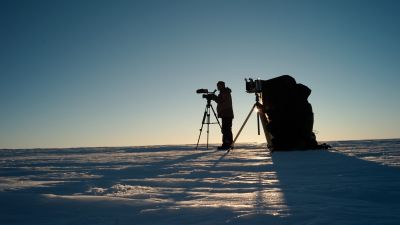
Traverse for the CHASE and CLIMB projects
Before his departure in mid-January, Preben Van Omeirmen from Ghent University went on a field expedition to the Antarctic Plateau and the coast to retrieve sampling devices and samples for the CHASE and CLIMB projects. Here are several photos taken during the expedition illustrating the vast expanses one encounters in Antarctica.
-
Preben Van Overmeiren and Alexis Merlaud are getting ready to use their special drill to collect samples of packed snow at different depths.
© International Polar Foundation
-
Once the core is collected, it is carefully pushed and sealed in a plastic bag, ready to be transported in a freezer back to Belgium, where it will be processed by a laboratory.
© International Polar Foundation
-
A 3-metre borehole is what remains after the sample has been taken.
© International Polar Foundation
-
Preben removes the filters of the passive atmospheric particle sampler located at one of the seven stations set up along a 250 km transect from the Antarctic Plateau to the Princess Ragnhild Coast in East Antarctica.
© International Polar Foundation
-
Different collectors are used to passively collect the atmospheric particles for the CHASE project.
© International Polar Foundation
-
As this is the end of the CHASE project, most of the atmospheric particle samplers need to be dismantled as well as the supporting poles that are sometimes buried two to two and a half meter under the snow
© International Polar Foundation
-
On our way to the coast, we will visit three of the CHASE atmospheric particle sampling points to collect the filters and the sampling devices. For comfort, we've travelling by Toyota Hilux, which allows us to carry all of our camping gear for a two-night stay in the field, not to mention all the equipment we need to sample snow. For security, we're following another traverse to the coast that will be nearby and can assist us in case of emergency.
© International Polar Foundation
-
Halfway to the coast, we find a "petrol station" of fuel drums that had been left along the trail we're taking to the coast. The hill where we stopped offers a perfect opportunity for a break during the long drive. We could have a picnic on the drums!
© International Polar Foundation
-
We're on the main highway to the coast. The leading party of tractors left fuel drums at specific locations along the trail, which will allow us to refuel on the way to the coast and on the way back to the station.
© International Polar Foundation
-
Once we arrive at the furthermost CHASE sampling point at Breid Bay (about 200 km from PEA) we take out the shovels to dig up and dismantle the atmospheric particle collector and its support rods buried deep in the snow.
© International Polar Foundation
-
It took us five hours to retrieve the the poles that were buried under several seasons of heavy snow.
© International Polar Foundation
-
A view of the midnight sun as we look back along the path we've taken in the Toyota Hilux.
© International Polar Foundation
-
We enjoyed our comfortable little campground near Breid Bay, Dronning Maud Land, and waking up to a nice morning in Antarctica under a clear, blue sky with no wind. We have a busy day ahead of us!
© International Polar Foundation
-
Preben prepares necessary equipment in the back of the Hilux to collect the CHASE project's atmospheric particle sampler.
© International Polar Foundation
-
Loaded with boxes that will store snow cores at freezing temperatures, our vehicle offers us some shelter when the wind start to blow.
© International Polar Foundation
-
Close to the edge of the Antarctic Ice Sheet, this atmospheric particle sampler will remain in place for another year.
© International Polar Foundation
-
Science brings you to the most extreme locations on earth. With the right equipment, we can understand more about Earth's climate and our footprint on our environment.
© International Polar Foundation
-
Another particle sampler with atmospheric particle samples to collect. This is how science works: sampling, sampling, sampling, analysing, comparing and drawing conclusions!
© International Polar Foundation
-
The sky is blue, but the wind is strong. Preben drills another snow core for his study.
© International Polar Foundation
-
We've drilled three boreholes in the snow. One for testing the machine and cleaning the corer, and two for taking snow samples at different depths.
© International Polar Foundation
-
Our modified Toyota Hilux with the midnight sun in the background.
© International Polar Foundation
-
We truly are in the middle of nowhere!
© International Polar Foundation






















